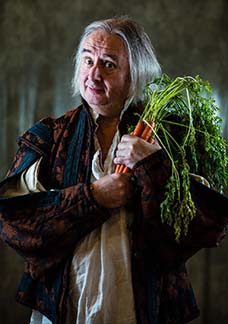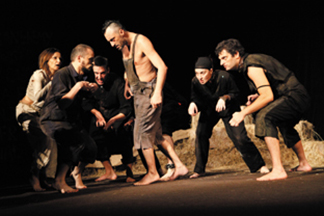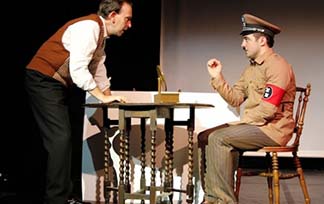By Lucy Komisar
The Edinburgh Fringe in August is the largest theater festival in the world, with hundreds of plays as well as musicals, dance, comedy, cabaret and spoken word performances.
I chose political plays, and nine out of ten I saw were excellent. I divided them into three groups, repression, war and politics. Here‘s the first group, about repression.
These riveting plays dealt with periods centuries apart. They are The Players Advice to Shakespeare” set in the 1600s, and two mirror plays of the 20th century, “Animal Farm” in Stalinist Russia and “Chaplin” in McCarthyite 1950s America. In each case, the playwrights and actors bring out the psychology of repression and rebellion.
“The Player‘s Advice to Shakespeare”

After seeing “The Player‘s Advice to Shakespeare,” I will never look at Shakespeare‘s plays in the same way again. In this stunning work by Brian K. Stewart, directed by John Koensgen, The Player (a powerful David Warburton), an actor in Shakespeare‘s company, challenges the morality of the playwright‘s choice of subjects for his plays.
It‘s 1607, the period of the enclosures of tenants‘ farmlands by nobles who want the communal property for sheep pastures. Sir Richard has forced his tenants off the land they worked. Now they are “vagabonds,” not a mild determination. Vagabonds are illegals. They can be brutalized, even mutilated by agents of the law.
The actor is in his 40s with straight gray hair to neck, breeches and a doublet and shirt with billowing sleeves. He begins hearing about a rising in the Midlands. Untidy characters are talking to crowds. People are breaking the hedges planted to enclose the land. He meets a challenger. “Why aren‘t you there with them?”
He wonders if he can get Will Shakespeare involved in the issue. “Think of justice, Will. Think of where we came from.”
He doesn‘t, and instead takes the road north out of London. There he meets two men who‘d lost everything. One had an ear and hand cut off by a judge. He says, “As an actor, I ridiculed people like you on stage.” It makes you think about Shakespeare‘s characters, how he dealt with the working class. Working class figures were clowns, never heroes!
In the Midlands, the actor sees entire sections of fence collapsing. Men pull plows through the enclosed pastures. Crowds roar. Then come soldiers with pikes and swords. Lines of soldiers mass on a hill. As the protestors appear unsure what to do, the actor uses his stentorian Shakespearean voice to direct them to save themselves: “To the trees!”
The return to London is dark. He thinks back, “I had to talk to Will about this. We had worked on the plays together. Will talks about acting holding a mirror to nature, not the nature I saw. I had to tell him to write a play that speaks about something real.”
Alas, the actor declaims that though the theater is the greatest sword of justice the world has known, Will, despite his origins has cast his lot with these “bastards.”
So, here‘s quite another way to look at Shakespeare. Lots of kings and queens in the Bard‘s plays, but where are the worker or peasant heroes? This enthralling production makes you think about that.
“The Player‘s Advice to Shakespeare.” Written by by Brian K. Stewart, directed by John Koensgen. Produced by the New Theatre of Ottowa.
“Animal Farm”
A moving poetic theatrical version of George Orwell‘s dystopian novel is performed by actors from Tiblisi, Georgia, the former Soviet state and the birthplace of Stalin. The language is Georgian, with supertitles, but it hardly matters, because the physical production directed by adapter-director George Masterson is so brilliant.
Workers and peasants on a farm seek to get rid of Farmer Jones, the man who oppresses them. The pig leaders say, “We are brothers; all animals are equals.” Jones should be overthrown and the fruits of the land be shared by the animals “Animalism,” says the pig leader, “is the way, comrades, to rebel against man.” They wear the same work clothes.
Some object, “Mr. Jones feeds us. If he didn‘t, wouldn‘t we starve?”
“Lies, comrades,” they are told.

It is physical theater, dance theater. The characters — horse, goat, chicken, pig, cow, dog – walk and sound like animals with their grunts, snorts, screeches, scraping of hooves.
The pigs announce the enemies, “Four legs or wings, friend; two legs, enemy. No animal can wear clothes.” One pig is comrade Napoleon. Another is the Squealer.
But a few animals raise questions. A goat inquires, “What will happen to the milk?” The pigs take it. Their dominance is supported by thuggish snorting black dogs.
When Snowball proposes building a windmill that will benefit all, he is banished, though later the idea is adopted as if it came from the insiders.
When the pigs announce an increase in production quotas for the hens, which will not benefit the hens, one chicken wants to promote rebellion. She is killed.
Meetings are banned, except to sing an anthem and provide workers with assignments. “Surely we don‘t want Jones back,” say the pigs. As their privileges grow, they have their “Comrade Squealer” keep watch on the others.
In a stylized dance, the animals struggle in toil, working harder than they ever did, dragging heavy bags of stones for construction.
The pigs hurl accusations. In a replay of the Stalin trials, one animal confesses he collaborated with Snowball to destroy the windmill. He is attacked and torn to pieces by the dogs. The pigs seem rather like the oppressive men with their rifles and whips they organized to oppose.
Their ideology, written on a huge canvas, changes as time passes. By the end, “All animals are equal, but some are more equal than others.”
This is a mesmerizing production of great artistry.
“Animal Farm,‘ adapted and directed by Guy Masterson, Theatre Tours International, (follow the link to fine analysis of the play.) Featuring the Tumanishvili Film Actors Theatre, Georgia.
“Chaplin”
It might seem odd to put a play about Charlie Chaplin in this group, but the seeds of repression are clear in the treatment of the film comedian whose renown could not protect him from sleazy FBI Director J. Edgar Hoover and his minions on the House Un-American (what a dystopian name!) Activities Committee.
A fine flashback play by Christoffer Mellgren and John Storgard, starring Christopher Page as the young Chaplin and James Bryce as the old man, takes us through the actor‘s beginnings in London slums, where his mother was institutionalized – you get the feeling her mental breakdown was related to their poverty. The famous film bit with the arms of “The Kid” outstretched calls up his recurring dream, with the cry, “Mother!” (The mother is finely portrayed by Sarah McCardie.)

In the story directed by Sven Sid, we see his development into a world famous comic actor. He gets into acting via his brother Sidney, given an excellent turn by John Scougall, and finds great success in Hollywood. But the part that‘s most interesting is when at 40 he makes “The Great Dictator,” a comedy about Hitler. He plays a barber who dresses as Hitler and gives an anti-fascist speech. I‘d have liked more detail, more video, of that speech.
Chaplin speaks at a rally of the Association of Russian Friendship urging America to enter the war. He‘s advised to stop such speeches, because people would say he was a communist. He argues, “You urged me to make a talking picture. Now you want me to be quiet. Hoover attacks him, with the public following as an obedient mob. The press turns against him, with right-wing Hedda Hopper (McCardie) leading the pack as she parrots FBI feeds. He is called before HUAC.
Forced out of the country, Chaplin spends the next decades in Switzerland with his wife Oona (Michelle Edwards), the daughter of playwright Eugene O’Neill. They don‘t return for a visit till 1972, when a change of political atmosphere leads the Hollywood bigwigs who had blacklisted him to welcome him back to a glitzy “we now love you” party. They even return his name to a famous sidewalk where it had been plastered over in 1958.
So the repression was short-lived. Or was it? Are you following the news? Stay tuned.
My chief criticism of “Chaplin” is the too-spare set (by Hanne Horte), just two tables and two chairs at opposite ends of the stage. It‘s probably due to the limited budget of most fringe productions. But lighting or scenic projections (by Mia Erlin) could have compensated. And the Chaplin videos could have been spread through the story to show how he used real life to inspire his films, rather than have most of them shown at once.
Still, it‘s an absorbing well-acted tale that needs to be told. To remind people that current U.S. thought police politics have a history.
“Chaplin.” Written by Christoffer Mellgren and Johan Storg¥rd, translated from Finnish by Julian Garner. Directed by Sven Sid. Review also at NY Theatre Wire.
Edinburgh Festival Fringe. Takes place every August.


Lucy Komisar gave us three fascinating reviews of what sound like intriguing plays from the Edinburgh festival. Can you let reader know if and when any of them come to the U.S. Thanks, Barbara Garson
LK: Some Edinburgh plays come to 59E59 Theaters. Will let you know.
Pingback: Edinburgh Fringe: The People the System Chews Up | The Komisar Scoop